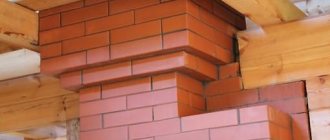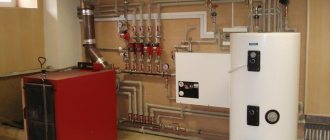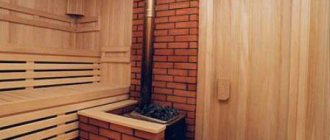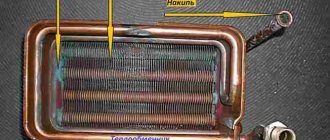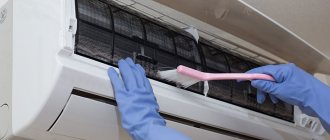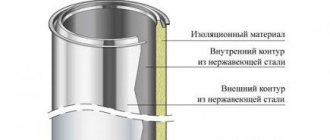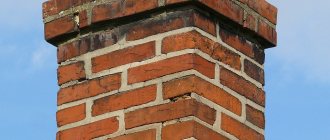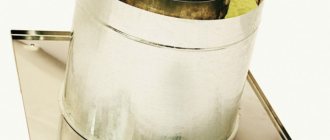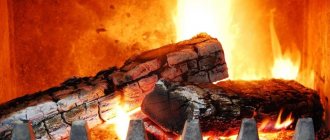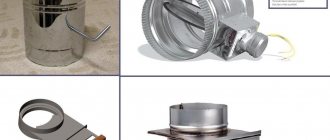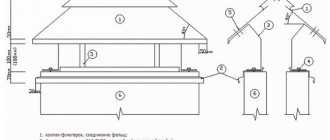Why does the chimney become clogged?
If, after cleaning, the pipe in the bathhouse soon becomes clogged again, you should think about the mistakes made in operating the stove. The chimney itself is not capable of coking quickly. Soot deposition occurs during fuel combustion. Solid particles of combustion products are removed through the chimney along with the smoke. Under a number of unfavorable conditions, all of them do not evaporate, but settle on the walls of the chimney in the form of soot accumulation.
Rapid pipe clogging occurs for the following reasons:
- When wood with a humidity of more than 24% is burned in a sauna stove, steam is released. It is mixed with the smoke and directed into the chimney. Inside the pipe, the hot flow meets cold air and condensation forms. Moisture settles as an acidic sediment on the inner walls of the bathhouse chimney, attracting solid smoke particles. Over time, there is a lot of savings. Soot gradually reduces and then completely blocks the internal cross-section of the chimney.
- It is better to heat the stove in the bathhouse with dry wood from deciduous trees. You cannot use plywood, chipboard, plastic or other waste for fuel. This fuel contains many binding chemical elements that produce sticky soot when burned. Advice! It is not advisable to use coniferous wood to fuel a sauna stove due to the resinous wood.
- The uninsulated bathhouse pipe on the attic and street sides condenses. Hot smoke passes along the cold inner walls of the chimney and forms droplets of water with an acidic sediment. Soot sticks to a wet surface.
- Turns, bends, and horizontal sections of the pipe are ideal places for soot deposits. It is ideal to lay the chimney in a bathhouse straight. If it is impossible to avoid bends, complex sections of the pipe are equipped with hatches to remove soot.
- The intensity of soot fouling of a chimney depends on its material of manufacture. A brick pipe is characterized by rough walls and irregularities that form seams. This surface is ideal for soot deposits. The inner walls of the metal pipe are smooth. It is difficult for solid particles to cling to, and they fly away along with the smoke.
- If the chimney of a bathhouse begins to clog quickly, it is worth analyzing all the reasons and correcting the shortcomings.
Cleaning soot with a brush
The most accessible and simple way to clean soot from a pipe in a bathhouse is to use a brush. Taking into account the individual characteristics of the chimney, you should choose a suitable model that can reach all corners and bends of the pipe and clean the chimney along its entire length.
It is best to use a brush with nylon fibers. Having sufficient strength and flexibility, such fibers penetrate deeply into the thickness of the soot layer and gently remove it without damaging the surface of the pipe.
The advantage of such a nylon brush is that it is perfectly capable of reaching the bends of the chimney pipe in order to remove soot and soot from there. But it is not advisable to use hard brushes in this situation, since they can leave scratches and nicks on the surface of the chimney, on which more soot will accumulate.
The flexible handle of this brush makes it easier to reach far corners and is convenient to manipulate.
How to determine when it's time to clean
A clogged sauna chimney will immediately make itself felt. You don’t need to be an expert here, but you should be wary if the following signs occur:
- The draft in the sauna stove has decreased. First you need to check the damper. If it is completely open and there is no traction, it is time to clean the pipe.
- The firewood burns well, but the flame gradually fades. The chimney is partially clogged.
- Ignition of fuel becomes more difficult. If the chimney is clogged, it is difficult to light even dry wood. The smoke has nowhere to go and extinguishes the flame.
- The color of the flame became dull orange. If there is good draft in the sauna stove, the flames stretch towards the chimney channel and have a bright color of red, orange, and blue.
- After lighting the stove, the bathhouse was filled with a pungent smell. In the absence of draft, the fumes enter the room. It can be easily identified by its watery eyes.
Important! If one of the reasons is observed, the chimney of the bathhouse must be urgently cleaned.
How to clean a pipe in a bathhouse
The procedure for cleaning a chimney in a bathhouse involves freeing the channel from soot and accidentally penetrated debris. After servicing the pipes, the firebox and furnace vent are put in order. You can clean the chimney of a bathhouse yourself using chemical, mechanical, and folk remedies. If actions are unsuccessful, a specialized team is invited.
Mechanical method
A chimney sweep is rarely seen these days, but the profession has not lost its relevance. Mechanical cleaning of the bath pipe is considered a radical method, which is recommended to be used twice a year. Cleaning the chimney from soot starts from the street side and ends with the firebox.
For work, a mandatory set of tools is used:
- Brush with flexible bristles. The diameter of the device is selected 2 times larger than the cross-section of the bath chimney.
- Rope for fixing the brush and immersing it inside the pipe. For chimneys with bends, it is better to use a cable. A ruff is attached to one end, and a handle for turning is attached to the other end.
- Steel load with a diameter of up to 50% of the cross-section of the bathhouse chimney. The weight is tied below the ruff for free movement down the pipe.
Auxiliary tools for cleaning the chimney include brushes and scrapers with long handles.
Mechanical cleaning of the pipe is carried out in dry, windless weather. You will need an extension ladder and a roofing hole if you have to climb onto the gable roof of the bathhouse. It is convenient to walk on a flat roof without a wooden manhole.
Before starting work, the stove in the bathhouse must cool down. The damper in the room is fully opened so that the collapsed soot flows through the pipe into the firebox. The entire oven is covered with a damp cloth to prevent contamination of the bath with black soot.
Mechanical cleaning of the pipe is performed in the following sequence:
- The cap is removed from the top of the bathhouse chimney and an initial inspection is made.
- A thick soot deposit always accumulates at the point where the cap is attached to the pipe. The layers are scraped off with a scraper, as deep as you can reach with your hand along the chimney.
- A ruff is tied to a cable or rope, a load is lower, and the device is lowered down the pipe. The mechanism cannot be rocked. An impact with a load may damage the chimney.
- The brush is advanced with progressive movements up and down, as far as the even length of the bathhouse chimney allows.
- If there are bends in the pipe inside the bathhouse, the spilled soot is removed through open hatches.
- From the firebox side, the chimney is cleaned with a long-handled brush. A flexible cable with a handle and a bristled tip will do. The cleaning process can be mechanized using a special flexible attachment on an electric drill.
The final work is to clean the firebox and ash chamber from soot. After removing the soot, good draft will appear in the furnace.
Advice! The presence of traction is checked with a paper strip or a burning match.
If a flame or the edge of a piece of paper pulls into the ash pan, the draft through the chimney is excellent.
Chemical method
A simple way to get rid of soot is based on burning chemicals in a firebox. Conventionally, they are divided into household and specialized substances. The first include:
- Naphthalene used to be sold in bags. Grandmothers put them in the closet to kill moths. A substance with a pungent odor and is highly flammable. Naphthalene should be burned with caution in small doses.
- The blue mixture is prepared independently from three components: copper sulfate, saltpeter, coke. The proportions are 5:7:2 in the listed sequence.
It is more convenient to use factory-made chemicals. The packaging contains instructions; the briquettes are packaged in portions for single use. The most popular are: “Log Chimney Sweep”, “Komichek”, “PHK”. There are other preparations for chimneys. It is optimal to select them for a bath empirically.
The video tells more about the use of chemicals:
Vacuum cleaning
Professional cleaning of pipes in a bathhouse with a vacuum is performed using special equipment. The nozzle of the device is immersed inside the chimney. A running motor, similar to a vacuum cleaner, creates a strong air flow. The soot flies out into the street from the chimney under high pressure.
The advantage is efficient cleaning. The vacuum expels soot from all secluded places on turns and bends, where it is difficult to reach with a brush. The disadvantage of this method is dirt. The roof of the bathhouse and nearby neighboring buildings are covered with black soot. In addition, the device is expensive. It makes sense to buy equipment as a group for several yards or to use the services of hired workers.
How and with what to clean the chimney
When using any solid fuel, products of incomplete combustion accumulate in the chimney, which settle on the walls in the form of a soft coating. If cleaning is not carried out in time, the clearance will decrease, which will significantly worsen traction. And so much so that smoke will go into the room. In the worst case, the soot can catch fire, which can lead to pipe destruction or even fire. Chimney cleaning is practically the only way to avoid this. It is necessary to inspect the condition of the pipe twice a year - before and after the heating season. How often you will have to clean depends on whether you use preventative chimney cleaning methods or not.
This is the result of soot igniting
There are two types of chimney cleaning:
- mechanical or traditional - using a special core and brushes;
- chemical - using natural soot “solvents” or artificial chemicals;
- thermal - soot is removed by burning.
Don't let your chimney get to this point.
Traditional cleaning - mechanical
Chimney sweeps have been cleaning soot this way for centuries. Cleaning is carried out from the roof. A special projectile is lowered into the pipe - a core, to the center of which a flexible cable is welded/attached. Above the core there is a brush that brushes away soot, and the core is a weighting element that simultaneously checks the permeability of the pipe. When working, you need to be careful: if the traction is good, soot and other debris will fly into your face. Therefore, first put on goggles and a respirator, and also stay attached to the pipe: with a sudden release in the face, a person involuntarily makes a sudden movement. You can probably imagine how this could end up on the roof.
Before starting work on the roof, be sure to insure yourself
This design - a ruff with a core on a cable - can be made independently, but the main catch is in the correct load. It should be round and centered. No ordinary weights or heavy pieces of iron are suitable. They work for the time being, and then the tied load becomes “stupid” in the pipe and cannot be removed from there by any effort. Often, in order to remove the projectile, disassembling a fragment of the chimney is required. If you are going to clean the chimney yourself, either make or buy a “correct projectile” that will under no circumstances get stuck in the chimney. Wrapping a brush, making it out of metal or synthetic bristles - these are details that usually do not cause difficulties.
Device for mechanical chimney cleaning
Sometimes the pipe is too high to be reached even from the roof. In this case, the chimney is cleaned from below. If the chimney is metal and there is a cleaning glass, unscrew it and insert a brush on a flexible rod into the pipe. In some cases, not rods are used, but rigid wire. If there is no glass, maybe there is a cleaning hole, but if there is none, then you will either have to disassemble the beginning of the chimney, or clean it through the firebox, which is completely inconvenient.
There is one more point: if the pipe is metal, cleaning with a brush is not enough - a large amount of plaque remains on the walls. To ensure high-quality cleaning, instead of a brush, wrap a ball of rags around a wire or rod. This chimney cleaning leaves behind almost perfectly clean walls.
Homemade brush for cleaning the chimney
One option is to make a cleaning brush from polypropylene pipes. The pipes are cut into fragments of approximately 1.5 meters. Threaded fittings are installed at the ends. A metal brush for an angle grinder is attached to one of them.
Homemade telescopic rod with brush
First, the wire on the brush is fluffed using pliers or pliers. It turns out to be a homemade telescopic cleaning rod for the chimney.
Watch the video to see how to make a chimney cleaner from a plastic bottle.
How to clean a very tall or curved chimney
Sometimes the pipe rises very high above the ridge. Why not call a special machine with a lifting platform every time to clean the chimney? The issue is resolved with the help of a very long cable, in the middle of which a brush of a suitable diameter is attached.
A small weight is tied to the end of the cable, thrown into the pipe, and pulled out from the other end. The cable remains inside, and its other end hangs outside. When the need arises to shake the soot, simply pull first one end, then the other, moving the brush tied to the cable. The total length of the cable is three pipe heights.
The problem of a pipe with a bend is solved in the same way - you only have to somehow pull the cable through the bend the first time, and then you only need to pull the ends of the cable.
Chemicals for cleaning soot
Any chemicals are only preventive measures and a way to make mechanical cleaning less frequent. You can cope without mechanical removal of plaque only if you have a stainless steel or ceramic chimney, and only with regular use of one or more products from this category.
Keep in mind that if you haven't cleaned your chimney in a while and you start using one of the chemicals, there is a chance that you will completely “plug” the draft. These substances do not remove or dissolve deposits, but only soften them. The softened soot and soot either flies away in the form of flakes into the chimney or falls down. If the stove is reversible, with long curved smoke channels, soot can clog the clearance. It will be necessary to open the cleaning windows, rake out the soot and everything that has fallen there. If the pipe is straight, after using these products you need to clean the firebox - within a few days the fallen sediment will fall into it.
Folk chemicals
Let's start with “folk” remedies for dissolving soot. Our grandmothers also periodically sprinkled some salt on burning wood. To ensure that the soot flies into the chimney and does not fall inside, the chimney is heated very well, with the fireman at full power for some time. Then half a kilogram or a kilogram of salt is poured into the fire and the fire continues for another hour and a half. If the pipe is hot enough, gray or black flakes begin to fly out into the pipe. Over the course of several days, residues may fall inside, but the bulk burns in the pipe.
Many people are well familiar with the effects of potato starch. In the same way, with a well-heated oven, pour about a bucket of potato peelings onto the firewood (you can use chopped potatoes, or you can use starch). The effect is almost the same, with the only difference being that almost everything falls inside.
Another option for “folk” chemicals for cleaning chimneys is burning several aluminum cans. In this case, the fire must be really hot: you need firewood with high heat capacity. Then the aluminum really burns - the can disappears in 5-7 minutes. If it just darkens, there will be no effect.
Store-bought drugs
There are various chimney cleaning products available in stores. Some of them are produced in the form of powder packaged in bags, others - in the form of logs or briquettes. Please read the instructions before purchasing. There are preparations intended for open fireboxes, such as a fireplace, and others for closed ones, such as sauna or heating stoves. It is not recommended to replace them - after all, chemistry...
How do chimney cleaning chemicals work?
The range of chemicals for cleaning chimneys is constantly updated, but there are drugs that have existed for decades. Their effects have already been well studied. Below we will talk about the most popular and common ones.
- Anti-carbon chemical composition. Powdered product, packaged in bags or in jars/buckets with measuring spoons. It is rationed strictly according to the amount of firewood; the dose cannot be increased. There are many such tools:
- Cheerful chimney sweep. A preventative agent that prevents the accumulation of deposits in the chimney. Periodically burned along with firewood.
- HG - for cleaning stoves and fireplaces (Netherlands). A product for removing existing plaque. This is a powdery substance packaged in a jar. Recommended use once every 6 months. Dose - 2 tablespoons on firewood with a previously well-heated stove (the dose can be slightly increased).
- Packaged product “Chimney Sweep Pro”. For one-time use, three sachets are burned at once; if there are already problems (craving has worsened), you can use up to 6 pieces. It is placed in burning firewood 20-30 minutes before the end of heating. After burning out, do not clean the firebox, but heat the stove/fireplace a couple more times with the remnants of this pile of firewood.
Some types of chemicals for cleaning chimneys
- Chimney sweep Under this name there are about a dozen formulations produced by different manufacturers, respectively, the dosage and rules of use are different.
- Kominiček (Czech Republic). A prophylactic agent that is poured into firewood or coal towards the end of the firebox.
- Hansa chimney cleaner. A universal product for any type of firebox and pipes, when using any type of fuel (wood and coal). To clean and remove already accumulated soot, pour 1-2 measuring scoops into each stack of firewood until the chimney is completely clean. To maintain normal condition, the product is added once every 3-4 fires.
- Log for cleaning chimneys. Name - Chimney Sweep, Sazhinet. Chemicals are added to a combustible mass and then formed into a briquette or log. The name is basically “Chimney Cleaning Log” or some variation of this name. There are many manufacturers of this product, but the composition and effects are not very different. This is a preventative agent - its regular use allows you to carry out mechanical cleaning less frequently.
One of the Chimney Sweeper logs for cleaning chimneys
The composition of these products, of course, is not disclosed; the principle of operation is described rather poorly: under the influence of gases released during combustion (safe for humans), the soot dries out, burns out, becomes brittle and flies out into the chimney or crumbles down. An example of such a log for cleaning a chimney from a German manufacturer is in the video.
Thermal chimney cleaning methods
The action of this method is based on the fact that soot is a high-calorie combustible substance. The temperature in the chimney is brought to the point where it flares up and burns out. The problem is that the combustion temperature of soot is about 1100°C and few chimneys and fire stops (when passing through a ceiling or roof) are able to withstand such heat.
Its one very unpleasant and dangerous feature is that if a lot of soot has accumulated, the moment of ignition is very similar to an explosion. Almost the same sound is heard, and the air wave is noticeable. So, in addition to extremely high temperatures, a significant shock load is also added. There were cases when even rough stoves fell apart. So this method is a dangerous undertaking.
Thermal cleaning is simple: take dry aspen firewood and heat the stove. Their combustion temperature is very high, and after a while the soot ignites. If you burn aspen periodically, the deposits simply do not have time to be deposited in sufficient quantities to cause any noticeable harm during combustion. But it is dangerous to use this method on a clogged chimney.
baniwood.ru>
How to clean a chimney in a bathhouse: folk methods
The chimney pipe of a bathhouse is not always clogged to a critical condition. In many cases, folk methods help get rid of soot.
Cleaning with water
The method is effective for metal pipes. Brickwork on clay will be washed away by water. The essence of cleaning is to uniformly wet solid deposits. A small amount of water is poured from the street into the pipe along the walls. When the dirty liquid begins to drip into the firebox, light a low fire. During combustion, continue to add water in small portions. Wet heated carbon deposits soften. When the wood burns out, a bucket of water is poured into the chimney. The soot along with the liquid will flow through the firebox into the ash pit. What remains is the unpleasant procedure of scooping out the slurry.
Burning potato peelings
A more humane method is based on burning potato peels in a sauna oven. You will need about half a bucket of cleaning. They are pre-dried and placed in the firebox after the loaded firewood has burned out. The starch released during combustion softens the soot. Soot falls into the firebox in layers.
Heating the stove with aspen wood
Soot tends to burn when exposed to high temperatures. Another folk method is based on this phenomenon. The sauna stove is heated with ordinary wood. When the pipe warms up, the firebox is loaded with aspen logs. When burned, firewood produces hot gases that burn soot.
Attention! A large portion of aspen firewood can lead to a fire or destruction of the sauna chimney.
Burning aluminum cans
Beer or aluminum cans, when burned, release substances that destroy soot. One container burns for approximately 9 minutes. Aluminum should burn, and not blacken or melt. You can achieve metal combustion by loading heat-intensive firewood.
Cleaning methods
Anyone can do the work of a chimney sweep. In order to do the job efficiently and competently, it is worth familiarizing yourself with the basic cleaning methods. The choice of method depends on the degree and nature of the violations in the chimney.
It is worth preparing the necessary tools to clean the internal surface of a clogged system. Each procedure requires not only basic knowledge, but also special tools. Some devices will have to be purchased at a hardware store, others may be found among household utensils.
It is impossible to single out the most effective method for cleaning a chimney. For each type of blockage, its own method and available substances are selected.
Mechanical
This method involves the use of physical force to remove soot and tar deposits in the chimney. The following tools may be suitable for the job:
Chemical
The use of chemically active substances to remove soot and plaque is in increasing demand. Such tools are created specifically for these purposes. Their composition is harmless and does not pose a risk to human health, but their use requires the adoption of certain safety measures.
The principle of action of the active substance is quite simple. Chemical powder or spray destroys the molecular structure of tar deposits and leads to their complete disintegration.
There is a fairly wide range of professional products on sale today, but experts recommend the following items:
Plaque is removed quite effectively and quickly using these chemicals. It is necessary to light the stove in the bathhouse and place the required amount of substance on the fire. During the combustion process, the drug will begin to produce evaporation, which will enter into a chemical reaction with the soot.
Traditional methods
There is no need to talk about the fact that the Russian bath has existed practically since ancient times. At different times, our ancestors invented various ways and methods for cleaning pipes. Folk remedies are still used today. They are completely harmless and have been tested for centuries.
Using plain water gives good results. The chimney sweep simply pours water into the channel with soot, trying to thoroughly wet the walls, after which he lights the stove and maintains a low fire in it. Resin deposits under the influence of moisture and heat will begin to soften and fall off. You can speed up the cleaning process by final rinsing with water, but only after the firewood has completely burned out.
You can use potato peels. It is laid out on a well-made fire and burned to ashes. Potato skins contain a large amount of starch, which softens and dissolves soot. After the fuel burns out, the system must be cleaned with a wire brush or water.
Cleaning pipes with snow is a proven and effective method that can only be used in winter. A dense lump of snow is compacted into the chimney at a time when the stove is already melted and a low fire is maintained in it. The snow gradually melts, slides down the walls of the canal and clears away the accumulated dirt.
As soon as 1 lump begins to slide, a second lump is laid after it. After such a general cleaning, the chimney must be dried, otherwise there is a risk of fungi and rust.
How to clean a pipe from soot in a bathhouse with your own hands
Cleaning the chimney pipe of a bathhouse is not a difficult task, but it is necessary to observe the order of work and accuracy.
Chimney inspection
Cleaning begins with an inspection. Based on the results obtained, a suitable method is selected. If the sauna chimney is equipped with inspection hatches, they are all opened. The accumulation of soot at the connecting joints of a metal pipe indicates their depressurization. The chimney will first have to be disassembled, each element cleaned and reassembled, treating each joint with heat-resistant paste.
Making your own pipe cleaning brush
If you don’t have a factory-made brush at hand, you can easily make one from a PET bottle. The diameter of the bottle is selected to approximate the cross-section of the pipe. The container must fit freely into the channel. The bottom of the bottle is cut off, the body is cut halfway into strips 1.5 cm wide, and folded over the sides. A rope is threaded through the neck, the load and the bottle itself are secured so that it does not move. The ruff is ready.
Important! Brushes with metal bristles should not be used to clean steel chimneys.
Primary cleaning
The chimney pipe of the bathhouse begins to be cleaned from the street. The first step is to dismantle the head. Thick soot build-ups are scraped off and thrown onto the ground or into a bucket. Clean the head itself. If the bathhouse has not been used for a long time, nests of birds, wasps, and wild bees can be found inside the chimney channel. All items are removed using hooks or other devices.
Soot removal
Based on the inspection results, one of the existing cleaning methods is selected. It is important to know that manufacturers of metal chimneys do not recommend burning them. Only the mechanical method is applicable here, but without the use of steel scrapers and brushes.
How to clean a brick chimney in a bathhouse
All existing methods are applicable for a brick channel. Filling water using the traditional method is excluded. Brushes will work even with metal bristles, but caution is needed. Scratched walls are an increase in the roughness of the channel. Soot will get caught on burrs and potholes, and the bathhouse pipe will clog faster. It is optimal to blow out a brick pipe using a vacuum method or clean it by burning chemicals.
Prevention
Preventive measures help extend the life of a bathhouse chimney. It is enough to burn chemicals, potato peelings, and aluminum cans 1-2 times a year. Salt, similarly, when burned, destroys carbon deposits well.
Recommendations for the operation of stoves and chimneys
The best fuel for a sauna stove is wood from deciduous trees. The logs are dried for at least 1 year under covered sheds. Such firewood never produces much soot.
You cannot burn garbage, plastic, or waste from repairs in the stove. A thrown spray can will explode in a fire, destroying the firebox and damaging the chimney. Do not light wet wood with diesel fuel or gasoline. It is unacceptable to completely load the firebox with logs. Great heat and flame will cause the soot to ignite.
Chemical method
There are several special drugs that are used for this method. When they are used, soot is destroyed and converted into carbon dioxide. The method is easy and safe, and the pipe material does not deteriorate.
To prevent blockages and as a cleaner, the drug “Chimney Sweeper” is used. To be effective, it is recommended to use it at least 2 times a month. When cleaning the chimney in a bathhouse, it is enough to throw the product into the firebox once every 2 months.
The “Smoke” product is popular - a box filled with a special mixture that does not have an unpleasant odor. When using a stove, the box is placed in the firebox. After a few hours, the chimney is cleared of blockage. The procedure is repeated every 3 months.
The Poleshko-TE product is also used for cleaning pipes, which is sent to the firebox after igniting the stove. It burns out after 2 hours, but it is recommended to leave the ash after it for 2 more fireboxes for better cleaning.
For preventive purposes, the drug “Sazhinet” is used, which helps to increase the heat transfer of materials used to light the stove. Its effect lasts for 2 weeks.
When using chemicals, you must strictly adhere to the instructions that come with them.
